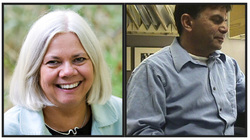Pam Moran & Ira Socol

Pam Moran & Iral Socol
Keynote topic:
It Is All Technology - How Space, Design, and Time Control Student Access to Learning
ICT never exists in a vacuum, its functions and uses are determined by the other technologies of the school - walls - furniture - time scheduling, and by environment encouraged by those designs. From the chairs of the 1830s to the Teaching Wall of the 1850s the technologies of the classroom were crafted for particular intentions in a particular world. Intentions and a world we may no longer share.
Today we hope to begin to challenge you to use technologies in truly transformative ways, for truly transformative pedagogy, by helping you to see - via new lenses - the structures and assumptions underlying education and its technologies.
Bios
Pam Moran and Ira Socol bring very diverse backgrounds to the conversations on technologies and leadership in contemporary education. Pam, the Superintendent of the Albemarle County Public Schools in Virginia has worked in every level of K-12 education, teaching science in high school and middle school, serving as a secondary assistant principal and an elementary principal, and as adjunct faculty for the University of Virginia. She has led curricular and professional development, and now supports a 13,000 student school division covering 726 square miles. Ira, a research and teaching assistant in the College of Education at Michigan State University, has worked in law enforcement, architecture, art and design before becoming a leader in technological services to those with special needs, working in universities (including teaching at both Michigan State and Grand Valley State Universities), K-12 schools, businesses, and vocational rehabilitation services. His research explores both the re-design of educational institutions with Universal Design technology and the history of education and technology, research which is done and presented globally.
Though Moran’s experience as a student was continual success, and Socol struggled through school as a special needs student, both have come to understand that the system design of the American school fails far too many children, and that real change, real reform, requires both new paradigms of leadership and new understandings of the process of learning.
Moran works in leadership roles in Virginia and national organizations, Socol through Michigan’s technology leadership program and projects and conferences around the world. The two have combined to begin rethinking top to bottom leadership in schools, working in part from the historical viewpoint that the post-industrial, post-Gutenberg age needs to reconnect with the human leadership forms which dominated previous ages, just as many of our communication skills now must look to models which existed prior to the invention of the printing press.
The inside-out and outside-in perspectives brought by these educators are unified through interactive storytelling, co-facilitated conversations which lead to direct change actions which begin to shift schools and classrooms from traditional environments to contemporary learning spaces. They believe that educators who think, laugh, dream, create, design and build together will accomplish deep change with agility, commitment, and understanding within their own school communities, moving teachers away from the teaching wall as the dominant form of instruction, engaging learners in passion-driven, project-based learning work, and using the communications technologies of the present and future to re-write the rules of access, inclusion, and connectivity.
